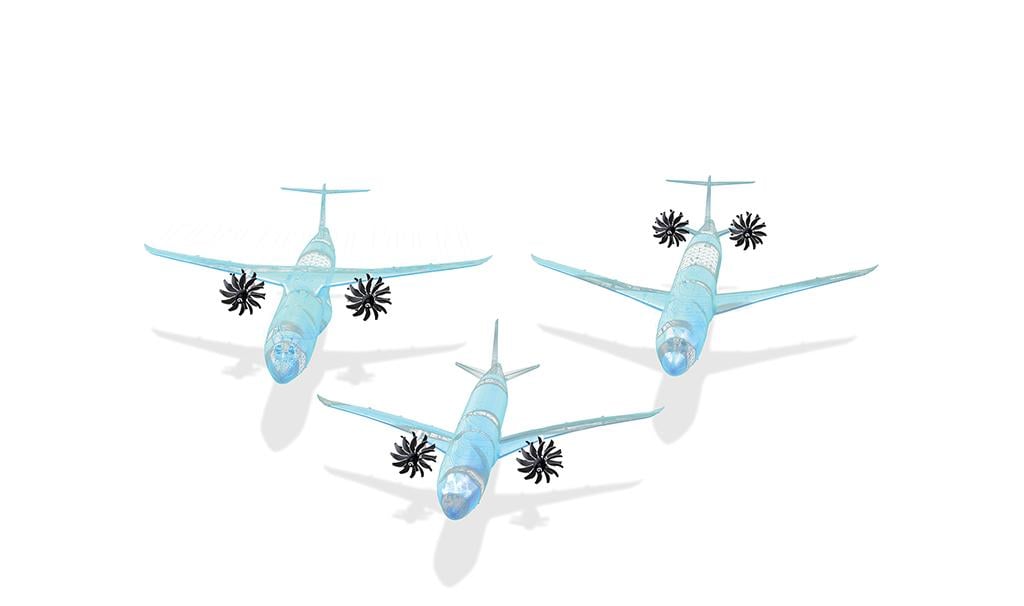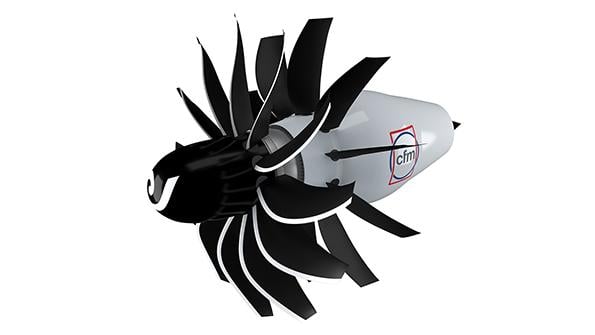
In its accelerating quest for sustainability, aviation needs a step change in fuel efficiency. Despite the risks, CFM believes its newly unveiled plan to develop an open-fan next-generation engine for the 2030s can help bridge that gap.
The bold move targets development of a single-stage, gear-driven fan paired with active stators in a puller, or tractor, configuration—a design never previously tested at full scale. Incorporating a rotor more than 12 ft. in diameter, the initiative also throws down the gauntlet to Airbus and Boeing, challenging them to consider more ambitious new single-aisle designs for the next decade.
- Open Fan aimed at 20,000-35,000-lb.-thrust sector
- Flight tests targeted by 2025
While competitors Pratt & Whitney and Rolls-Royce have adopted higher-bypass gear-driven turbofans for their future engines, why would the CFM partners—GE Aviation and Safran Engines—gamble on the technically ambitious open fan? Although the concept increases bypass ratio by eliminating the fan duct and offers double-digit efficiency gains due to a lower fan-pressure ratio, it has so far failed to progress beyond the experimental stage.
The answer, says CFM, is timing and technology. Since open rotors were first conceived in the 1970s, the fate of the concept has been wedded to the price of oil. When the cost of jet fuel dropped in the late 1980s, so did interest in open rotors. The aerospace industry’s recent strategic pivot toward sustainability has effectively severed this link. The future of efficient propulsion is now increasingly driven by the imperative for net-zero carbon emissions and is no longer a hostage to energy costs alone.
Technologically, the engine venture believes the concept is ready for prime time because, after more than a decade of research and development on both sides of the Atlantic, it says the key challenges of noise and airframe integration can be overcome. Aero-acoustic advancements—ranging from improved computer-based blade designs to optimized interstage spacing—have brought open rotors within reach of future noise limits, and more progress is still possible, says CFM.
But significant challenges remain. In order to accelerate the plan while reducing risk, the new engine will be developed as part of a suite of disruptive technologies under CFM’s newly unveiled Revolutionary Innovation for Sustainable Engines (RISE) program. Targeting a 20% reduction in fuel consumption and CO2 emissions compared with current engines, RISE is aimed at a successor to the current Leap 1 turbofan in the 20,000- 35,000-lb.-thrust class.
CFM believes the move to an open rotor will keep next-generation powerplants on track to meet internationally agreed-upon targets of halving CO2 emissions by 2050. While much of industry’s research focus is on electric and hybrid-electric systems for smaller aircraft, the power needs of larger aircraft will require continued improvements to gas-turbine-based engines—of which the open fan is one.

Although the direct-drive Leap 1 introduced a 15% fuel-burn and emissions improvement over the CFM56 in the late 2010s, CFM says the prospect of a further 20% savings makes the open-fan concept attractive for next-generation, single-aisle designs into the 2030s. “It’s hard for any airframe maker not to get excited,” says John Slattery, GE Aviation president and CEO. “They’re enthusiastic to learn a lot more. We’ve been working on this technology since 2019, and we’ve kept our airframe partners apprised of the broad areas.”
As part of the wider focus on sustainability, RISE will also include the development and test of multiple new combustor designs to ensure future compatibility with sustainable aviation fuels (SAF) and liquid hydrogen. The demonstrator open-fan engines will also be configured with motor-generators to enable them to be adapted to hybrid-electric operation.
By including both SAF and hydrogen-capable combustor designs, the technology demonstration program supports the differing future fuel strategies adopted by Airbus and Boeing. Hydrogen fuel is now a central plank of Airbus’ planning for its next-generation regional and single-aisle designs, while Boeing has committed to certifying its product line to operate on 100% SAF by 2030. “To make it compatible with liquid hydrogen is challenging, but not so much on the engine side,” says Safran CEO Olivier Andries. “Around 90% will be the same—the challenge is mostly integration with the aircraft systems.”
“In pursuit of this carbon reduction, we think the time is right,” says Arjan Hegeman, general manager of GE Aviation’s advanced technology operation. “The open-fan architecture eliminates the whole structure that sits around the fan. So you take a lot of weight out, you take a lot of drag out, and you get the ultimate propulsive efficiency. It’s impossible to get any better.”
RISE builds on earlier unducted fan development work by GE and Safran that dates back to the 1980s, as well as more recent work with research and regulatory agencies in Europe and the U.S. The initiative will be a follow-on to the Safran-led Counter-Rotating Open Rotor (CROR) project that was completed in 2017 under the €200 million ($240 million) SAGE 2 (Sustainable and Green Engine) project within Europe’s Clean Sky aeronautics research program.
Safran and GE-owned Avio Aero have proposed a follow-on demonstrator program under Clean Aviation—a successor program to Clean Sky under the European Union’s broader Horizon Europe research and innovation framework (AW&ST Oct. 28-Nov. 8, 2020, p. 14). Assuming Clean Aviation contracts are awarded, the RISE initiative would be supported in part by European government research funding.
Clean Aviation is slated to run in 2022-28 and include ground and flight demonstrations. Within this architecture, CFM aims to conduct an extensive series of component tests, building up to initial flight tests in Victorville, California, around 2024-25. The switch from earlier pusher demonstrators, like the CROR and GE36, to a puller enables flight testing on some existing testbed aircraft without the need for major airframe modification. The puller configuration also allows for mechanically simpler integration.
The RISE open fan will include a new compact high-pressure core to boost thermodynamic efficiency, as well as a recuperating system to preheat combustion air with waste heat from the exhaust. The demonstrator will also incorporate the use of advanced materials such as ceramic matrix composites in the hot section and resin-transfer-molded composite fan blades.
A distinctive new feature of the open fan is a second nonrotating stage of active, variable-pitch stators that will act as flow recovery vanes. The design increases overall fan-pressure ratio while simultaneously reducing rotor loading—thus enabling a higher maximum flight Mach number. The rotating front stage will be powered by a high-speed booster compressor and a high-speed, low-pressure-shaft-driven front gearbox.
“We simplified the architecture compared to the GE36 and CROR,” says Delphine Dijoud, executive manager of the RISE program for Safran. “You have just one rotating stage, and after that you have guide vanes which are stators. Both stages have pitch control, so you can have variable pitch and reverse capability.” The design eliminates the contrarotating stage and associated rotating frames, saving weight and improving reliability.
Improved fan efficiency will help reduce size, aiding airframe integration and lowering noise, says GE Aviation’s Hegeman. “We have been fine-tuning the technologies and our engineering tools to get the acoustics where they need to be,” he says. “We have also been able to shrink the fan from a 16-ft. diameter in this thrust class back in the 1980s to a 12-13-ft. diameter today. That’s not much bigger than today’s outside diameter of a nacelle, which makes it very installable on narrowbody-type airframes. So we can hit the acoustics requirements in our thrust class while gaining double-digit performance improvements.”
The demonstrator will also pave the way for development of a certified product, various issues for which were considered as early as 2015 in a European Union Aviation Safety Agency (EASA) notice of proposed amendment. “The open-rotor concept is not intended to be certified as a propeller/engine installation,” says EASA. “Due to the complex integration, it is instead intended to be certified as an integrated engine concept.”
Based on current airframe and engine certification requirements, the open-fan propulsion system will likely need to meet existing turboprop rules—under which the propeller manufacturer has to demonstrate that a fan blade cannot detach. In addition, the design will be expected to meet current requirements on blade pitch control and avoiding overspeed conditions. Blade-off requirements similar to current turbofan regulations will also be a factor for the airframe-maker.
-—With Jens Flottau in Frankfurt



Comments
Really good idea. There is no fan duct to catch the debris before it lands in a passenger's lap.